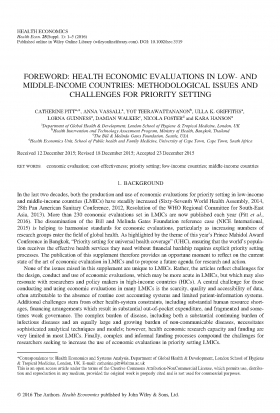This website uses cookies so that we can provide you with the best user experience possible. Cookie information is stored in your browser and performs functions such as recognising you when you return to our website and helping our team to understand which sections of the website you find most interesting and useful.
Foreword: Health Economic Evaluations in Low- and Middle-income Countries: Methodological Issues and Challenges for Priority Setting

รายละเอียดเพิ่มเติม
CATHERINE PITTa,*
ANNA VASSALLa,
YOT TEERAWATTANANONb,
ULLA K. GRIFFITHSa,
LORNA GUINNESSa,
AMIAN WALKERc,
NICOLA FOSTERd and KARA HANSONa
aDepartment of Global Health & Development, London School of Hygiene & Tropical Medicine, London, UK
bHealth Intervention and Technology Assessment Program, Ministry of Health, Bangkok, Thailand
cThe Bill & Melinda Gates Foundation, Seattle, USA
dHealth Economics Unit, School of Public health and Family Medicine, University of Cape Town, Cape Town, South Africa
1. BACKGROUND
In the last two decades, both the production and use of economic evaluations for priority setting in low-income and middle-income countries (LMICs) have steadily increased (Sixty-Seventh World Health Assembly, 2014, 28th Pan American Sanitary Conference, 2012, Resolution of the WHO Regional Committee for South-East Asia, 2013). More than 230 economic evaluations set in LMICs are now published each year (Pitt et al., 2016). The dissemination of the Bill and Melinda Gates Foundation reference case (NICE International, 2015) is helping to harmonise standards for economic evaluations, particularly as increasing numbers of research groups enter the field of global health. As highlighted by the theme of this year’s Prince Mahidol Award Conference in Bangkok, “Priority setting for universal health coverage” (UHC), ensuring that the world’s population receives the effective health services they need without financial hardship requires explicit priority setting processes. The publication of this supplement therefore provides an opportune moment to reflect on the current state of the art of economic evaluation in LMICs and to propose a future agenda for research and action. None of the issues raised in this supplement are unique to LMICs. Rather, the articles reflect challenges for the design, conduct and use of economic evaluations, which may be more acute in LMICs, but which may also resonate with researchers and policy makers in high-income countries (HICs). A central challenge for those conducting and using economic evaluations in many LMICs is the scarcity, quality and accessibility of data, often attributable to the absence of routine cost accounting systems and limited patient-information systems. Additional challenges stem from other health-system constraints, including substantial human resource shortages, financing arrangements which result in substantial out-of-pocket expenditure, and fragmented and sometimes weak governance. The complex burden of disease, including both a substantial continuing burden of infectious diseases and an equally large and growing burden of non-communicable diseases, necessitates sophisticated analytical techniques and models; however, health economic research capacity and funding are very limited in most LMICs. Finally, complex and informal funding processes compound the challenges for researchers seeking to increase the use of economic evaluations in priority setting LMICs.
Full Text: http://onlinelibrary.wiley.com/doi/10.1002/hec.3319/abstract




